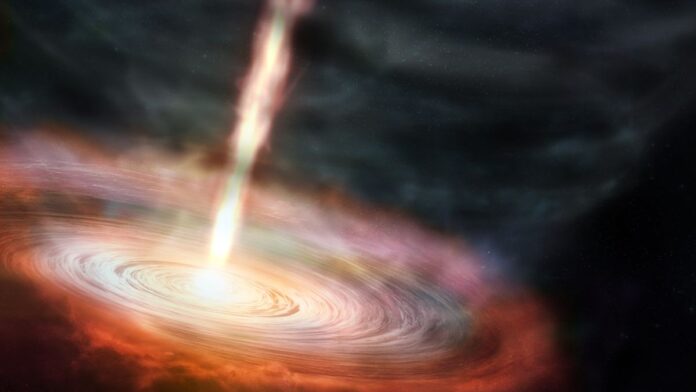Astronomers have discovered a hitherto unseen jet of material being ejected from a distant massive “oddball” star at a staggering speed of over a million miles per hour. It is believed that the high-speed jet is being driven by the magnetic forces of the unusual star.
The team made the discovery while studying masers, naturally occurring amplified microwave radio emissions, around the massive star designated MWC 349A with the Atacama Large Millimeter/submillimeter Array (ALMA). The findings could help scientists better understand how massive stars evolve.
MWC 349A is located around 4,000 light-years from Earth in the constellation Cygnus and is not only one of the brightest radio sources in the sky but is also one of only a handful of objects known to be surrounded by hydrogen masers.
Related: Pew, pew! Scientists detect record-breaking ‘megamaser’ 5 billion light-years away
Because of its unique features, MWC 349A which has roughly 30 times the mass of the sun, has become the subject of intense study in optical, infrared, and radio wavelengths. And yet nothing like this jet had been seen emerging from the star before.
“Our previous understanding of MWC 349A was that the star was surrounded by a rotating disk and photo-evaporating wind. Strong evidence for an additional collimated jet had not yet been seen in this system,” lead author and undergraduate research assistant at the Center for Astrophysics | Harvard & Smithsonian (CfA) (opens in new tab), Sirina Prasad said.
The discovery was made in part because masers make it easier to study processes that are otherwise too small to see, thus allowing Prasad and the team to uncover the previously unseen structures in the star’s immediate environment.
“A maser is like a naturally occurring laser,” Prasad said. “It’s an area in outer space that emits a really bright kind of light. We can see this light and trace it back to where it came from, bringing us one step closer to figuring out what’s really going on.”
In addition to spotting this high-speed jet, the study of masers also allowed the team to map MWC 349A’s surrounding disk in detail for the first time.
“We used masers generated by hydrogen to probe the physical and dynamic structures in the gas surrounding MWC 349A and revealed a flattened gas disk with a diameter of 50 AU [1 AU is approximately 93 million miles the distance between the sun and the Earth] approximately the size of the Solar System, confirming the near-horizontal disk structure of the star,” project principal investigator and CfA senior astrophysicist Qizhou Zhang, said. “We also found a fast-moving jet component hidden within the winds flowing away from the star.”
The jet of material is rocketing away from the star so fast that it would cover the distance between San Diego, California, and Phoenix, Arizona in a literal blink of an eye. The team thinks that the source of this incredible speed is a magnetic force called magnetohydrodynamic wind. The movement of this type of wind is controlled by the interaction of a star’s magnetic field and the gases in its surrounding disk.
“Although we don’t yet know for certain where it [the jet] comes from or how it is made, it could be that a magnetohydrodynamic wind is producing the jet, in which case the magnetic field is responsible for launching rotating material from the system,” said Prasad. “This could help us to better understand the disk-wind dynamics of MWC 349A, and the interplay between circumstellar disks, winds, and jets in other star systems.”
The team’s findings were presented at the 241st proceedings of the American Astronomical Society (opens in new tab) on Monday, Jan. 9.
Follow us on Twitter @Spacedotcom (opens in new tab) or on Facebook (opens in new tab).

